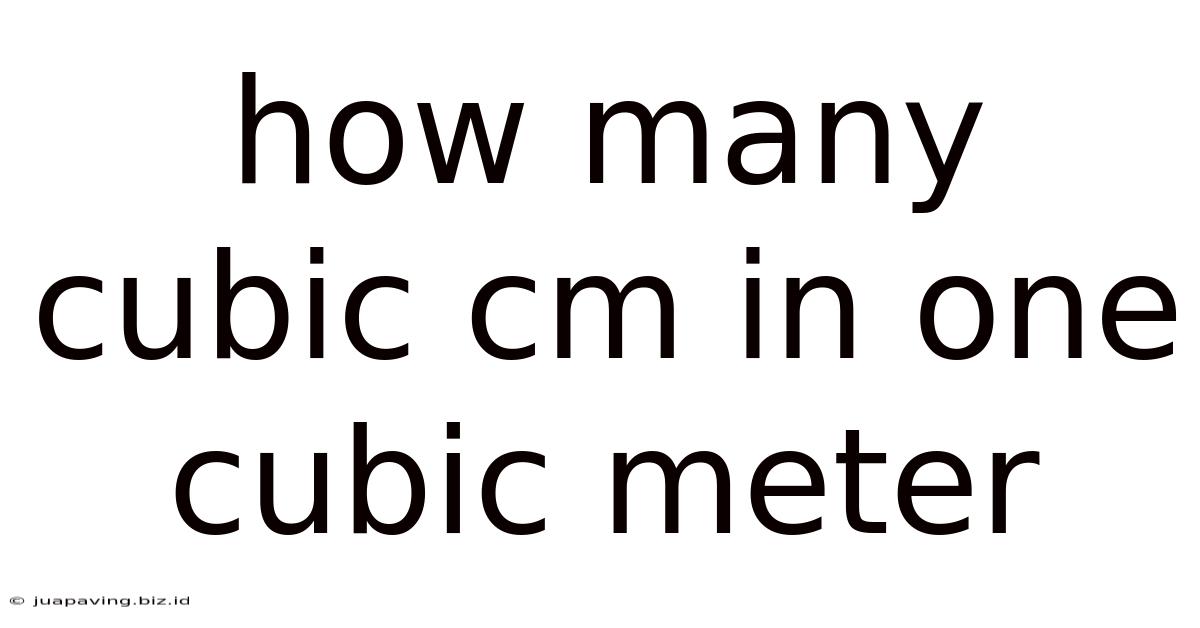How Many Cubic Cm In One Cubic Meter
Juapaving
May 12, 2025 · 4 min read

Table of Contents
How Many Cubic Centimeters in One Cubic Meter? A Comprehensive Guide
Understanding unit conversions is fundamental in many fields, from engineering and construction to everyday calculations. One common conversion that often causes confusion is the relationship between cubic centimeters (cm³) and cubic meters (m³). This comprehensive guide will not only answer the question "How many cubic centimeters are in one cubic meter?" but also explore the underlying principles, provide practical examples, and offer tips for mastering these conversions.
Understanding Cubic Units
Before diving into the conversion, let's establish a clear understanding of cubic units. A cubic unit represents the volume of a cube with sides of a specific length. For instance:
- Cubic centimeter (cm³): A cube with sides of 1 centimeter (cm) each.
- Cubic meter (m³): A cube with sides of 1 meter (m) each.
The key difference lies in the scale. A meter is significantly larger than a centimeter; specifically, 1 meter = 100 centimeters. This difference in scale drastically impacts the volume comparison between cubic centimeters and cubic meters.
The Conversion: Cubic Centimeters to Cubic Meters
To understand the conversion, we need to consider the relationship between linear units (centimeters and meters) and their cubic counterparts. Since 1 meter equals 100 centimeters, we cube this relationship to find the equivalent volume:
(1 m)³ = (100 cm)³
This simplifies to:
1 m³ = 1,000,000 cm³
Therefore, there are 1,000,000 (one million) cubic centimeters in one cubic meter.
Practical Applications and Examples
This conversion is crucial in various real-world scenarios. Let's explore some examples:
1. Construction and Engineering
Imagine you're calculating the volume of concrete needed for a foundation. The dimensions of the foundation might be given in meters, but the concrete might be ordered in cubic centimeters. This conversion is essential for accurate ordering and avoiding material shortages or waste.
Example: A foundation has dimensions of 5 meters x 3 meters x 0.5 meters. To calculate the volume in cubic meters, we multiply: 5 m * 3 m * 0.5 m = 7.5 m³. To convert this to cubic centimeters, we multiply by 1,000,000: 7.5 m³ * 1,000,000 cm³/m³ = 7,500,000 cm³.
2. Liquid Measurements
While liters are commonly used for liquid volume, the conversion to cubic centimeters provides a useful connection to solid volumes. Knowing that 1 liter is approximately equal to 1000 cubic centimeters, you can easily translate between liquid and solid volume units.
Example: A container holds 2.5 liters of water. This is equivalent to 2.5 liters * 1000 cm³/liter = 2500 cm³. If you need to find the volume of a container that can perfectly fit this amount of water, the volume would be 2500 cm³.
3. Scientific Research and Experiments
In laboratories, precise volume measurements are critical. Many experiments involve tiny volumes of liquids or solids, often measured in cubic centimeters (or milliliters, which are equivalent). Understanding the relationship between cubic centimeters and cubic meters allows for accurate scaling and data interpretation across various experiments.
Mastering Cubic Unit Conversions: Tips and Techniques
Converting between cubic units can sometimes feel challenging. Here are some tips to make the process easier:
-
Visualize the Cubes: Imagine a large cube representing a cubic meter. Then, visualize how many smaller cubes (cubic centimeters) can fit inside it. This visual representation can improve understanding.
-
Break Down the Conversion: Instead of memorizing the large number (1,000,000), break the conversion into smaller, manageable steps. Remember that 1 m = 100 cm, then cube each side to derive the cubic relationship.
-
Use Dimensional Analysis: This powerful technique helps ensure that units cancel out correctly. Start with the known value and multiply by conversion factors until you reach the desired units.
-
Practice Regularly: Like any mathematical skill, consistent practice strengthens understanding and improves speed and accuracy. Work through various examples with different units and volumes.
Beyond Cubic Centimeters and Meters
The principles discussed here extend beyond just cubic centimeters and meters. The same logic can be applied to conversions involving other cubic units, such as:
- Cubic millimeters (mm³): 1 cubic centimeter contains 1,000 cubic millimeters.
- Cubic kilometers (km³): 1 cubic kilometer contains 1,000,000,000,000 cubic meters.
Understanding the fundamental relationship between linear and cubic units empowers you to confidently navigate these conversions.
Conclusion
The conversion from cubic centimeters to cubic meters, and vice versa, is a fundamental skill with wide-ranging applications. While the conversion factor of 1,000,000 might seem daunting, understanding the underlying principles and utilizing practical techniques simplifies the process. By mastering this conversion, you enhance your ability to tackle problems in various fields requiring accurate volume calculations, strengthening your understanding of spatial relationships and enhancing your problem-solving capabilities. Remember to practice consistently and utilize dimensional analysis to ensure accuracy and confidence in your calculations.
Latest Posts
Latest Posts
-
What Is 37 As A Fraction
May 12, 2025
-
Magnesium How Many Protons Neutrons And Electrons
May 12, 2025
-
What Are 3 Equivalent Fractions For 2 3
May 12, 2025
-
Barium Chloride And Sodium Sulfate Balanced Equation
May 12, 2025
-
Greatest Common Factor Of 10 And 20
May 12, 2025
Related Post
Thank you for visiting our website which covers about How Many Cubic Cm In One Cubic Meter . We hope the information provided has been useful to you. Feel free to contact us if you have any questions or need further assistance. See you next time and don't miss to bookmark.